| | |
Warning: This infobox has missing parameters: subgroup, type and unrecognized parameters: era, members, imageBG
- "The Empire will always strike back!"
- ―Gilad Pellaeon
The Imperial Military, also known as the Imperial Service, was the armed forces of the Galactic Empire, and successor to the Republic Military, as Palpatine did nothing to halt the massive military build up that had produced an army of troopers and enormous weapons of mass destruction following the Clone Wars.[1] It was responsible for carrying out military operations throughout the galaxy as well as maintaining order on Imperial member worlds, governorships, colonies, and protectorates. Its soldiers followed the Imperial Military Code. The military itself was under the direct control of Imperial High Command. Although the Galactic Emperor acted as the Commander-in-Chief of the Military, Palpatine rarely ever left the confines of his palace on Coruscant, leaving a relative few military personnel ever actually seeing him face to face.[1] The next highest rank was that of the Supreme Commander. The individual who held this title had complete control over the Imperial Military, and answered only to the Emperor. In the absence of an official Emperor, the Supreme Commander often became the de-facto leader of the Empire, as was seen in the cases of Grand Admiral Thrawn and Gilad Pellaeon. This position was held by several different Imperial officials over the course of the Empire's history, including Darth Vader, Thrawn, and Gilad Pellaeon.
The Imperial Military was not only a physical superpower, but a mental one as well. Vader's stormtrooper division, the 501st Legion, known as "Vader's Fist," inspired fear in any sentient species. The infamous Death Stars were used by Emperor Palpatine to frighten the galaxy's citizens into submission. These are only a few examples of the fact that pure fear of the Empire's might was often more effective than might itself. Much of the equipment used by the Empire was designed to enhance this effect, the fear-inspiring appearance of the AT-AT being one example of this phenomena.
The Imperial Military was considered a massive organization, with tens of trillions of regular army soldiers, trillions of fleet crew, and a sizable force of stormtroopers.[2]
Organization
- "The Empire maintains order. People like you disrupt that order."
- ―Sarkli
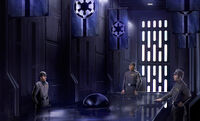
A meeting of military officers.
There were numerous branches in the Imperial Military, each for a different purpose. The Army and Stormtrooper Corps were used for ground missions. The Imperial Navy was responsible for space operations, the protection of space lanes, and the transportation of all Army troops (though it had little influence over their activities). The Imperial Department of Military Research (IDMR), based in the Maw Installation, was responsible for creating new, advanced technologies for use by the Imperial Military ranks. Battle Station Operations managed security space stations used by the Empire, such as the Death Stars.
The Imperial Military was more specialized than might first appear. In fact, three different branches of the Imperial Military participated in the famous Battle of Hoth: The Imperial Army was responsible for the assault vehicles, AT-ATs and AT-STs, the Stormtrooper Corps was responsible for a frontal assault, and the Imperial Navy was responsible for the blockade of the planet.
Even though they worked together, each branch had a separate command structure, and there was very little interference between the branches. For instance, Stormtroopers were often stationed aboard the vessels of the Imperial Navy and offered support to the Imperial Army, but remained under a different administrative command structure.
Branches of the Imperial Military included:
- Imperial Army
- Imperial Department of Military Research
- Imperial Diplomatic Corps
- Imperial Engineering Corps
- Imperial Exploration Corps
- Imperial Navy
- Imperial Navy (Aquatic)
- Imperial Stormtrooper Corps
- Imperial Survey Corps
- Battle Station Operations
- Imperial Surgical Corps
- Imperial Military Police
- Internal Safeguards Division
- Imperial Sector Rangers
- Commission for the Preservation of the New Order
- Imperial High Command
- Imperial Biological Weapons Division
- Imperial Palace Guard
- Emperor's special reserve guard
The Imperial Military also had ties to the Imperial Security Bureau and Imperial Intelligence, though they weren't actual branches. In addition, although part of the military, those with the title of Warlord of the Empire were considered distinct from the other branches in the military, as well as being among the highest ranks in the military chain of command.
Personnel and vehicles
Troopers
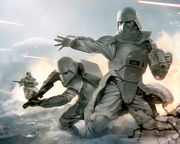
An Imperial snowtrooper captain
The Empire used many foot soldiers in battle. Stormtroopers, the most common, were the backbone of the Imperial military, serving as the Empire's soldiers, much like many of them did as clone troopers during the Clone Wars. Some stormtroopers were clones left from the Clone Wars, but Emperor Palpatine decided to start cloning other soldiers from different men and start recruitment after the Kamino Uprising. There were also specialized versions, such as Dark troopers and snowtroopers, that were tasked with specific goals as well as to work in specific environments. Many of the projects to create greatly enhanced stormtroopers failed, such as the Dark Trooper project and the attempt to create Force-sensitive stormtroopers. Stormtrooper Command was tasked with the coordination and leadership of this branch of the Imperial military. For punishment, Imperial officers who failed to complete their duties were forced to serve in the Stormtrooper Corps, or were—more often than not—executed for incompetence.
Types of Troopers:
- Army Pilot
- Aquatic assault stormtrooper
- Dark Trooper
- Engineer
- Imperial Pilot
- Imperial Marine
- Scout trooper
- Shock Trooper
- Snowtrooper
- Stormtrooper
- Sandtrooper
- Zero-G assault stormtrooper
Ground Vehicles
Walkers were the critical component of the Imperial Ground Forces.
Walkers such as AT-STs and AT-ATs symbolized the might and resources of the Empire. They were giant weapons of war, feared by all. Many believed such weapons to be invincible. However, the AT- AT had two fatal flaws—its neck and its legs. (Rebel Snowspeeder pilots exploited this weakness on Hoth.) After the formation of the Empire at the end of the Clone Wars, many vehicles left over from that previous galactic conflict were used by the military, along with Separatist light vehicles, such as the Dwarf Spider Droid. Later on in the Empire's existence as the primary galactic power, older vehicles, such as the AT-AP, Juggernaut,(Juggernauts were used in action on Hoth) and cargo AT-TEs were used in the Outer Rim.
Other vehicles used less widely known included the AT-AA, AT-PT, MT-AT, and the TX-130T fighter tank. These units were not as famous as their counterparts but also very dangerous to enemy units.
Imperial Fleet
Executor-class Star Dreadnought
The culmination of the Star Destroyer design came in the form of the Executor-class Star Dreadnought, which was larger and more powerful still. Several Executor-class ships were known to have been constructed, including the original Executor, the Lusankya, the Iron Fist and one other Super Star Destroyer of unidentified class which served much later on fighting against the Yuuzhan Vong.
Eclipse-class Super Star Destroyers
The fleet also used two Eclipse-class Super Star Destroyers during Operation Shadow Hand. These mighty ships were equipped with superlasers powerful enough to melt a planet's crust.
Imperial Star Destroyers
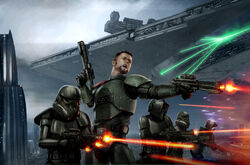
Admiral Victor Strang with his superlaser-equipped Star Destroyer, Conqueror
Although Venator-class Star Destroyers had served valiantly in the defense of the Republic during the Clone Wars, the rise of the Galactic Empire quickly turned the powerful vessels into symbols of fear and intimidation. The Venator and Victory-class Star Destroyers were stripped of their Republic markings and became the first of many warships that would comprise the Imperial Starfleet. Despite the total collapse of the Confederacy of Independent Systems, the Empire's military spending would only increase, leading to the development of the Imperial-class Star Destroyer. Eventually, the former Republic vessels would be phased out in favor of the new Imperial class, which would become the primary symbol of Imperial space power.
Immobilizer 418 cruiser
The Immobilizer 418 cruiser, also known as the Interdictor-class heavy cruiser, Interdictor-class Star Destroyer, or Interdictor-class medium frigate, was a 600-meter-long cruiser built on the standard Vindicator-class heavy cruiser hull. This vessel was equipped with 4 gravity well projectors, massive devices that projected pseudo-gravity that could prevent a vessel from escaping into hyperspace. The New Republic captured the remaining Immobilizer 418s, and upgraded their gravity- well projectors.
Frigates
The Empire used many capital ships as frigates. Some of the most common were the Victory II-class Star Destroyer and the Carrack-class light cruiser. They varied in size and power, but each was still a force to be reckoned with. They were more specialized than Star Destroyers, and though Star Destroyers were the backbone of the Fleet, frigates were more commonly used, unless a major battle was at hand.
TIE series
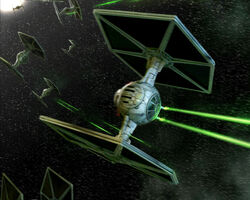
TIE fighter formation.
The Empire had millions of TIE series starfighters, coming in many varieties. All varieties of the TIE (except for the TIE Defender, TIE Hunter, TIE Avenger, TIE Phantom, and the TIE Advanced X1), however, lacked shields. This made the craft more vulnerable than the other ships used in the Imperial Military, forcing the pilots to fly with greater precision, demanding the highest skill from each one.
The TIE Fighter was the Empire's most common fighter. Though the fighter had no shields, it was very fast, and, most important to Palpatine, it was cheap. There were many variations on the original, such as the TIE Interceptor, the TIE Bomber, and the TIE Defender. With the exception of the Defender, all were relatively cheap and extremely efficient.
The Imperial R.O.E. (Rules Of Engagement) stated that Imperial TIE Fighters must have a 3 to 1 ratio advantage over enemy fighters in order to engage. Beating the enemy in numbers was a key part of Imperial strategy.
History
- "Fear will keep the local systems in line—fear of this battlestation."
- ―Grand Moff Tarkin, speaking of the Death Star
The Imperial Military formed as a realignment of the Republic Military. Originally formed when then Supreme Chancellor Palpatine was authorized to create a Galactic Military under his Emergency Powers, the Grand Army of the Republic was formed by clones from facilities on Kamino. These clones were created from the DNA of Jango Fett under orders from Jedi Master Sifo-Dyas.
Following the Clone Wars and the transformation from Republic to Empire, the clones were given new armor and weapons, and went from fighting droids to suppressing planetary uprisings on planets such as Naboo. Palpatine used the lack of a surrender from the Separatist leaders to continue to build up his army and navy, although he was aware that they were all dead. After the Kamino Uprising, Palpatine decided that having an entire army based on a single template was too dangerous, and began to diversify. The 501st Legion, remained pure. According to the New Order's ideology of human supremacy, the stormtroopers remained on the whole, human.
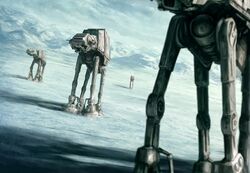
AT-AT in attack formation during the Battle of Hoth
After facing a droid uprising on Mustafar led by Gizor Dellso, the biggest threat to the Imperial Military was the Alliance to Restore the Republic. The two sides fought for years, in a conflict spanning the entire galaxy. The three biggest battles were at Yavin, Hoth, and Endor. Even though the Empire was victorious at Hoth, dealing a grievous blow to the Rebels, the Battles of Yavin and Endor resulted in major Alliance victories. In fact, Endor would see the end of the Empire's founder and his right hand man (Vader), sending the Imperial Military into chaos.
Following defeat at the hands of the New Republic, the Imperial Military split to follow multiple leaders, depending on their location and direct command. Several factions were led by officers and warlords such as Warlord Zsinj, Ysanne Isard, and Grand Admiral Thrawn. Though they all came close to defeating the New Republic, especially Thrawn, all ultimately failed. When Palpatine returned, much of the military sided with him. After his final defeat, the retreated to the portion of space known as Imperial Space. They would later reunite with the New Republic to fight the Yuuzhan Vong. After about 40 ABY, the Imperial Remnant began to regain power; after the Battle of Caamas in 130 ABY, it was once more the dominant faction in the galaxy. However, the Imperial Military was divided again when Emperor Fel was forced out of power. Parts of the military remained loyal to him, and after its formation served the Galactic Federation Triumvirate.
Imperial regulations
The Imperial military had various regulations that were required to be followed. One of these was for all Imperial vessels to release garbage into the vacuum of space before making a hyperspace jump.[3] Another was that, the moment when an executive vessel (such as a Lambda-class T-4a shuttle) had lowered its ramp, all personnel within the docking area were to stand at attention.[4]
Behind the scenes
In A. C. Crispin's book, The Paradise Snare, it is subtly hinted that The Imperial March is "the martial theme of the Imperial Navy."
Death Star Designer provides a few information on the color symbolism in the imperial military. It says "no one is ever fired or telekinetically executed for choosing Imperial Grey. It's the traditional color for imperial ships and stations". It also talks about "Sith Black", which "adds a touch of ancient dread to any battle station". "Stormtrooper White" is said to be "the perfect choice for the battlestation designer that knows that what we don't see is more terrifying than what we do". Finally, "Republic Red" follows the teaching of "co-opting the legacy of republican traditions".
Appearances
Non-canon appearances
Sources
- Galaxy Guide 1: A New Hope, First Edition (As "Imperial Armed Forces")
- Imperial Sourcebook, First Edition
- Rebel Alliance Sourcebook, First Edition
- Super Empire Strikes Back Official Game Secrets
- Galaxy Guide 3: The Empire Strikes Back
- Star Wars: The Roleplaying Game, Second Edition
- Imperial Sourcebook, Second Edition
- The Galactic Empire Scrapbook
 Star Wars Customizable Card Game — [[Unknown set: No set defined!]]
Star Wars Customizable Card Game — [[Unknown set: No set defined!]] Star Wars Customizable Card Game — [[Unknown set: No set defined!]]
Star Wars Customizable Card Game — [[Unknown set: No set defined!]] Star Wars Customizable Card Game — [[Unknown set: No set defined!]]
Star Wars Customizable Card Game — [[Unknown set: No set defined!]]- Shadows of the Empire Sourcebook
Star Wars: Shadows of the Empire|Star Wars: Shadows of the Empire (Pack: Dash Rendar) (backup link) (Indirect mention only)
- Shadows of the Empire Planets Guide
 "Shape-shifters" — Star Wars Adventure Journal 12
"Shape-shifters" — Star Wars Adventure Journal 12- Star Wars: Rebellion: Prima's Official Strategy Guide
 "Classic Moment" — Star Wars Insider 106
"Classic Moment" — Star Wars Insider 106- Rebellion Era Campaign Guide
- Book of Sith: Secrets from the Dark Side
- Star Wars: Beware the Sith
- The Essential Guide to Warfare
- Star Wars: The Ultimate Visual Guide: Updated and Expanded
- Star Wars: Edge of the Empire Core Rulebook
- Star Wars: Force Collection (Card: Darth Vader (★★★))
- Star Wars: Force Collection (Card: Stormtrooper (★★★, Tantive IV))
Notes and references
- ↑ 1.0 1.1 Star Wars: The Complete Visual Dictionary
- ↑ Rebellion_Era_Campaign_Guide
- ↑ Star Wars: Episode V: The Empire Strikes Back
- ↑ Death Star Owner's Technical Manual

